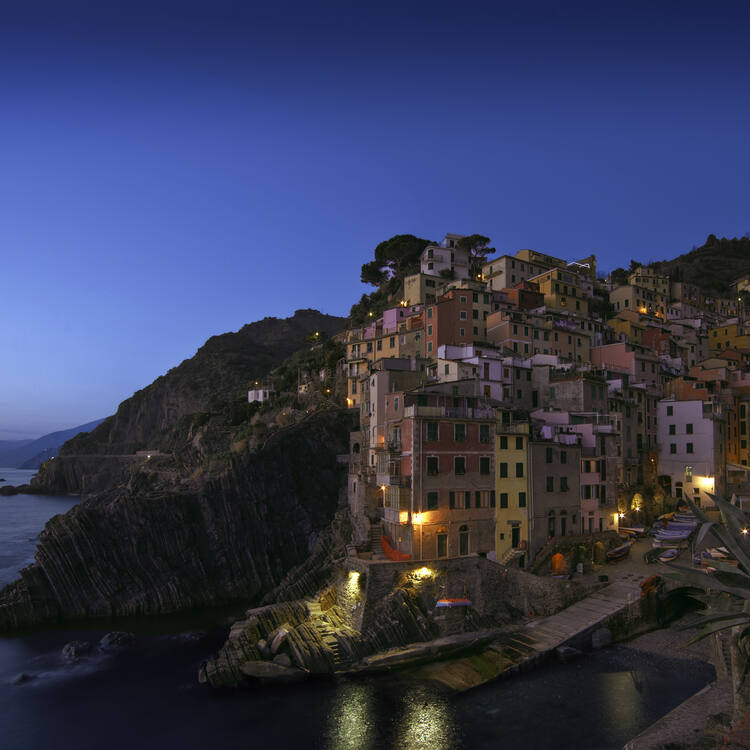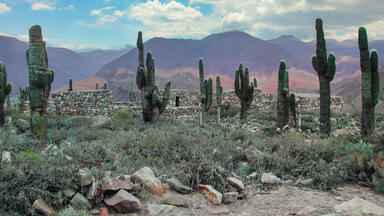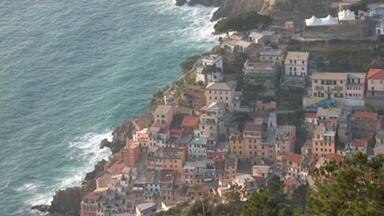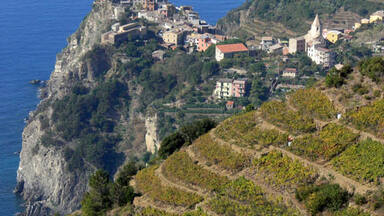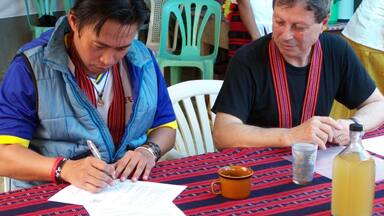Portovenere, Cinque Terre, and the Islands (Palmaria, Tino and Tinetto)
Portovenere, Cinque Terre, and the Islands (Palmaria, Tino and Tinetto)
The Ligurian coast between Cinque Terre and Portovenere is a cultural landscape of great scenic and cultural value. The layout and disposition of the small towns and the shaping of the surrounding landscape, overcoming the disadvantages of a steep, uneven terrain, encapsulate the continuous history of human settlement in this region over the past millennium.
Description is available under license CC-BY-SA IGO 3.0
Portovenere, Cinque Terre et les îles (Palmaria, Tino et Tinetto)
Ce territoire côtier ligurien qui s'étend des Cinque Terre à Portovenere est un paysage culturel de grande valeur panoramique et culturelle. La forme et la disposition des petites villes et le modèle du paysage environnant, surmontant les désavantages d'un terrain escarpé et irrégulier, marquent les jalons d'une occupation humaine continue dans cette région au cours du dernier millénaire.
Description is available under license CC-BY-SA IGO 3.0
بورتوفينيري، تشينكي تيرّي والجزر (بالماريا، وتينو وتينيتّو)
تشكل هذه الأراضي الساحلية الليغورية التي تمتدّ من تشينكي تيرّي إلى بورتوفينيري مناظر ثقافية ذات قيمة جمالية وثقافية عالية. فشكل المدن الصغيرة وترتيبها ونموذج المناظر المحيطة التي تعلو نتوءات أرض وعرة وغير منتظمة، تشير إلى أسس وجود بشري مستمر في تلك المنطقة خلال الألف الأول للميلاد.
source: UNESCO/CPE
Description is available under license CC-BY-SA IGO 3.0
韦内雷港、五村镇以及沿海群岛
位于五村镇与韦内雷港之间的利古里亚滨海地区是有着重要风景和文化价值的文化风景区。小城镇群的分布格局以及其周围的风景结构,不仅表明了对陡峭、破碎不堪的地势的征服,而且生动记述了过去1000年以来人类在此长期定居的历史。
source: UNESCO/CPE
Description is available under license CC-BY-SA IGO 3.0
Город Портовенере, культурный ландшафт Чинкве-Терре, острова Пальмария, Тино и Тинетто
Лигурийское побережье между Чинкве-Терре и Портовенере – это культурный ландшафт, обладающий большой эстетической и исторической ценностью. Удачные планировка и расположение небольших городков, а также формирование окружающего ландшафта компенсируют неудобства, связанные с крутизной склонов и пересеченным характером местности. Территория отражает основные этапы в истории развития человеческих поселений в этом регионе за последнее тысячелетие.
source: UNESCO/CPE
Description is available under license CC-BY-SA IGO 3.0
Portovenere, Cinque Terre y las Islas (Palmaria, Tino y Tinetto)
Situado en la costa ligur, entre Cinque Terre y Portovenere, este sitio posee un paisaje de gran belleza panorámica y alto valor cultural. El trazado y la disposición de las pequeñas ciudades, así como la configuración del entorno natural, no sólo muestran cómo el hombre ha superado las dificultades inherentes a un terreno escarpado y accidentado, sino que también constituyen todo un compendio de la ininterrumpida historia de los asentamientos humanos en esta región a lo largo del último milenio.
source: UNESCO/CPE
Description is available under license CC-BY-SA IGO 3.0
ポルトヴェネーレ、チンクエ・テッレ及び小島群(パルマリア、ティーノ及びティネット島)
ポルトヴェーネレとチンクエ・テッレの間のリグーリア海沿岸地帯は、その絶景と文化的価値において高度な文化的景観を呈している。今なお近寄りがたい険しい斜面にブドウの段々畑が営まれ、小集落が点在する一帯は、ほぼ完全にその伝統と奇勝に富んだ景観を今に伝えている。source: NFUAJ
Portovenere, Cinque Terre en de eilanden Palmaria, Tino en Tinetto
De oostelijke Ligurische Rivièra tussen Cinque Terre en Portovenere is een cultureel gebied van bijzondere waarde. Het weerspiegelt de harmonische interactie tussen mens en natuur in een buitengewoon schilderachtig landschap, dat een traditionele manier van leven illustreert die al 1.000 jaar bestaat en nog steeds een belangrijke sociaaleconomische rol speelt binnen de gemeenschap. Het gebied beslaat ongeveer 15 kilometer tussen Levanto en La Spezia. Het is een zeer grillige, steile kustlijn, die de bewoners door de millennia heen hebben getransformeerd tot een terrasvormig landschap om zo een paar hectare grond bruikbaar te maken voor landbouw, zoals wijngaarden en olijfbomen.
Source: unesco.nl
Outstanding Universal Value
Brief synthesis
Stretching 15 km along the eastern Ligurian coast between Levanto and La Spezia, the jagged, steep coastal landscape has over centuries been intensively developed with stone walled terraces for the growing of vines and olive trees. The area was almost inaccessible, except by sea, until the Genoa-La Spezia railway was built in the 1870s.
The property, extending from the Punta Mesco in the west and to the Punta Persico in the east, encompasses the territory of Porto Venere, the three islands of its archipelago (Palmaria, Tino and Tinetto), and the Cinque Terre, the collective name of the five villages of Monterosso, Vernazza, Corniglia, Manarola and Riomaggiore.
Some of the cultivation terraces extend to as much as 2 km in length. Terraces extended along the steep slopes from a few meters above sea level to up 400 m a.s.l., the highest altitude suitable for cultivation. They were mostly built in the 12th century, when Saracen raids from the sea had come to an end. The drystone walls are most often carefully constructed of sandstone rough blocks, bonded together with pebbles removed from the ground.
The maintenance of the terraces and the cultivation of vines and olive trees on the terraces reflect a communal approach to farming and the collaboration and cooperation of the communities without which such cultivation would not have been possible.
The natural garrigue and maquis vegetation survives intact in the higher parts of the steep ridge. The nature of the terrain and the vegetation provides food and shelter for a wide range of insect and animal species.
The local communities have adapted themselves to this seemingly rough and inhospitable environment by living in compact settlements on the coast or in small hamlets on the hillsides (e.g. Volastra, Groppo, Drignana, San Bernardino or Campiglia), erected directly on the rock with winding streets. The general use of natural stone for roofing gives these settlements a characteristic appearance. They are generally grouped around religious buildings or medieval castles. The terraces are also dotted by innumerable tiny stone huts isolated or grouped together (e.g. at Fossola, Tramonti, Monestiroli or Schiara) used for temporary shelter during the harvest.
The main five villages of Cinque Terre date back to the later Middle Ages. Starting from the north-west, the first is the fortified centre of Monterosso al Mare, that is a coastal town grown along two short valleys and facing one of the few beaches that exist in the area. Vernazza has developed along the Vernazzola water-stream on the slopes of the rocky spur protecting the village from the sea. Corniglia is the only village which has not been built on the coast itself but on a high promontory projecting to the sea. Manarola is a small hamlet in which the houses are ranged in part on a rocky spur running down towards the sea and partly along the Grappa stream. The most eastern – southerly village is Riomaggiore; its houses line the narrow valley of the Rio Maggiore water-stream, today covered to be used as main street.
Portovenere was an important commercial and cultural centre dating back to the Roman period, from which archaeological remains survive in its vicinity. It is compact in form, the houses aligned along the coastline culminating in the Doria Castle, which dominates the settlement and is a historical palimpsest, with many traces of its medieval predecessor.
Off the coast at Portovenere, the three islands of Palmaria, Tino and Tinetto, noteworthy not only for their natural beauty but also for the many remains of early monastic establishments that they contain.
The rugged and visually dramatic coastal landscape, with its tall compact settlements and visually spectacular terraces that were shaped over almost a millennium, is an exceptional testimony to the way traditional communities interacted and still interact with their difficult and isolated environment to produce a sustainable livelihood.
Criterion (ii): The eastern Ligurian Riviera between Cinque Terre and Portovenere is a cultural site of outstanding value that illustrates a traditional way of life that has existed for a thousand years and continues to play an important socio-economic role in the life of the community.
Criterion (iv): The Ligurian coastal region from Cinque Terre to Portovenere is an outstanding example of landscape where the layout and disposition of small towns, historically stratified, in relation to the sea, and the shaping of the surrounding terraces that overcame the disadvantages of a steep, uneven terrain, encapsulates the continuous history of human settlement in this region over the past millennium.
Criterion (v): Portovenere, Cinque Terre, and the Islands (Palmaria, Tino and Tinetto) is a remarkable cultural landscape created by human endeavour over a millennium in a rugged and dramatic natural environment. It represents the harmonious interaction between people and nature to produce a landscape of exceptional scenic quality.
Integrity
The landscape and settlements as we know them today have come down to us thanks to the assiduity and perseverance over the years with which humans have constantly repaired the stone walls surrounding the cultivated fields in order to allow agriculture to flourish. The traditional communal and collaborative viti-cultural and agricultural systems are an essential attribute for the outstanding universal value of the property.
At the time of inscription, it was estimated that 130 m of walls per hectare of vineyard and 30-300 m per hectare of olive grove were in need of urgent reconstruction. Since then, mechanisms for linking tourism activity and landscape maintenance have been activated and programmes for the reclamation of the terraced landscape have allowed recovery of some tens of hectares to vines and olive cultivation. Also communal activities for marketing wine have been strengthened.
Some abandoned terraces are now highly vulnerable to landslides, and there is a need for these to be mapped and recorded.
Re-afforestation also is becoming a threat to the terraces, and its impact needs to be addressed.
Monumental constructions have been subject to restoration, so that on the one hand the additions of several periods have been handed down to us and on the other the oldest parts of them have been retained, so that we can now consider this area of territory as a particular portrait of the history, the economy, and the life of the communities of Liguria.
Despite damages suffered from floods to some of the villages and to the watercourses leading down the terraced slopes, the effects of the floods have been limited to specific areas, and the major landscape and settlement features have not been substantially and permanently altered. Although damage was restricted to certain areas, the affected areas have not been yet restored completely. Mitigation measures need to be assessed for their impact on the outstanding universal value of the property in advance of work being carried out.
The floods have highlighted the vulnerability of the property to natural disasters and the need for risk preparedness measures to be developed.
The visual setting of the property is vulnerable to anticipated and unanticipated changes and needs to be adequately protected.
Authenticity
The property is an example of a “cultural, evolved organic landscape”. Its authenticity relates to sustaining the traditional farming and viti-cultural systems and their integrated settlements. These have been maintained in spite of the pressures caused by the modern social-economic development. Nevertheless the terraced agricultural system, including the maintenance of the terraces and the water management systems, remains highly vulnerable and will need much support to allow farmers to add value to their produce in order to sustain their livelihoods and the landscape.
The authenticity of the settlements relates to sustaining the traditional methods and materials and the use of traditional craftsmanship.
Protection and management requirements
Individual buildings, urban ensembles and archaeological remains within the nominated area are protected under the provisions of the basic Italian cultural property protection, the Decreto Legislativo 42/2004, Codice dei Beni Culturali e del Paesaggio (legislative Decree 42/2004 Cultural Properties and Landscape Code): a provision of law which establishes that any activity within the site must be authorized by the relevant Soprintendenza (peripheral office of the Ministry for Cultural Heritage and Activities).
In addition, the entire area of the municipalities of Cinque Terre and Portovenere falls under the provisions of the Cultural Heritage and Landscape Code as protected landscape. As a result, all interventions require the approval of the relevant authorities responsible for landscape and heritage protection and planning (Municipalities, Provinces, Regions and the Soprintendenze). Additionally, a Regional Coordination Landscape Plan is in force since 1990 for the entire region, operating at the territorial, local, and detailed level, defining levels of possible interventions related to the landscape features of each identified area. Finally, each of the municipal administrations has its own master plan which, according to the regional urban law (L.R. 36/1997), must contain measures that consider the landscape qualities.
The property enjoys the existence of several other provisions of law dedicated to its protection implemented by ad hoc authorities:
The Regional Law No. 12/1995 designated the area as part of the Regional Natural Park of Cinque Terre (Parco Regionale Naturale delle Cinque Terre); this brought with it compliance with the provisions of the national Law No. 394/1991 on protected areas, which imposes stringent controls over all forms of activity within the designated park.
Following the inscription in the World Heritage List, in December 1997 the Protected Marine Area was established and, in 1999, the Regional Natural Park was transformed into a National Park (President of the Republic’s Decree 6.10.1999).
The territory of the Islands of Palmaria, Tino and Tinetto, the marine area in the southwest direction of these isles (marine protected area) and a significant section of the land surface which includes the medieval village of Porto Venere, have been included in the Regional Park of Porto Venere.
The town of Porto Venere is subject to the detailed plan of the historic centre approved in 1992, which foresees some particular recovering strategies.
Currently, a number of plans and safeguard regulations concur to ensure the management of the property, particularly the two park plans elaborated according to the existing provision of law for the National Park of Cinque Terre and the Regional Park of Porto Venere (l.r. 30/2001). A first Plan for the Cinque Terre Park was adopted in 2002 and introduced some specific restrictive regulations to protect the site. The Plan must be regularly reviewed and updated.
The introduction of the Regulation of the Cinque Terre Marine Protected Area in 2005 aims at the protection of the sea area.
The Plan for Porto Venere Regional Park defines different restricting regimes for use according to the features of the territory so as to ensure the retention of the values of property. The property includes some “Sites of EC Interest” that have been designed to guarantee the maintenance of the conservation of the landscape and the local flora and fauna.
Protected buildings such as the churches of St Peter in Portovenere and St Venerius (Tine) and the Castle in Portovenere are the subject of systematic restoration campaigns by the peripheral offices of the Ministry of Culture. There are also regular maintenance programmes for all the protected monuments.
There are strict limitations on the establishment of tourist facilities. Measures have been envisaged to support the maintenance of the terraces and of the landscape as well as farming activities, however these apply on a voluntary basis. Maintaining the terraces remains the responsibility of individual farmers and landowners.
The territory of the property is under the responsibility of two different bodies the National Park of Cinque Terre and Regional Park of Porto Venere, the latter coinciding with the Municipality of Porto Venere. Additional management responsibilities are charged on the Municipalities, the Provinces and the Ligurian Region. Within the new management plan, submitted in 2016, a new management protocol has been signed by all relevant stakeholders. It establishes a structured management system, which includes a Coordination Committee, with steering and control tasks, the Community of the Municipalities of the future buffer zone, to ensure their participation in decision making and promotion activities, a permanent technical-administrative working group, tasked with the implementation of the actions of the management plan, the “Office for the UNESCO site”, which supports the permanent working group and is responsible for monitoring and periodic reporting. The role of site manager is occupied on rotation by the President of the National Park of the Cinque Terre and the Mayor of the Municipality of Porto Venere. A consultative committee is also envisaged to provide advice on research and other management matters.
In consideration of the multiple levels of protective and planning tools in place, the management system/plan for the property must ensure that the OUV of the property is respected by all these instruments and that coordination and harmonization mechanisms among their provisions are established and implemented.
Links
-
Municipality of Beverino (in Italian only)
-
Municipality of Riccò del Golfo (in Italian only)
-
Municipality of Levanto (in Italian only)
-
Municipality of Pignone (in Italian only)
-
Municipality of Vernazza (in Italian only)
-
Official website of the World Heritage property
-
Sistema Turistico Locale (in Italian)
-
Città della Spezia (in Italian)
-
Ambiente in Liguria (in Italian)
-
Comune di Monterosso al Mare (in Italian)
-
Portovenere (in Italian)
-
Parco Naturale Regionale di Porto Venere (in Italian only)
-
 View photos from OUR PLACE the World Heritage collection
View photos from OUR PLACE the World Heritage collection
-
Studio per la planificazione e la Conservazione dei Terrazzamenti delle Cinque Terre (only in Italian)
-
Consorzio Turistico Cinque Terre: Monterosso, Vernazza, Corniglia, Manarola, Riomaggiore
-
Parco Nazionale delle Cinque Terre
